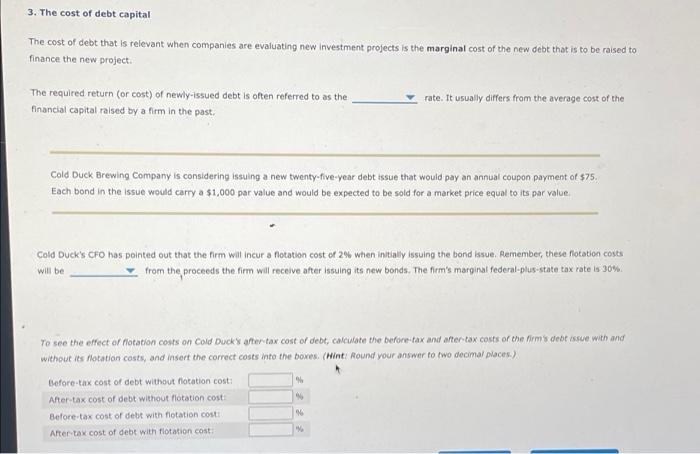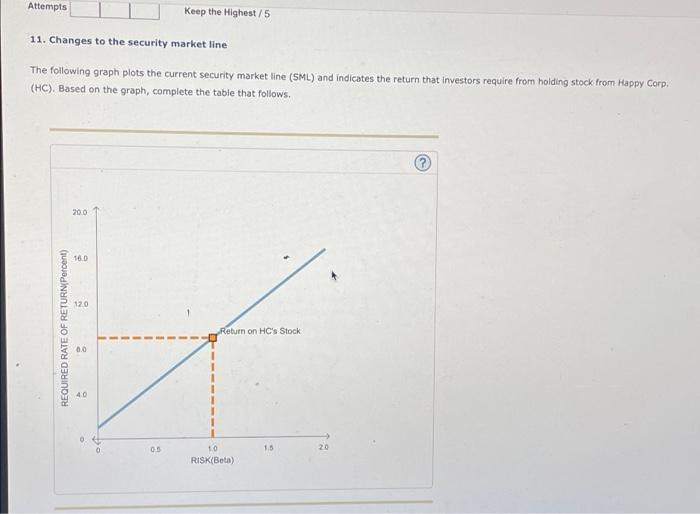Answered step by step
Verified Expert Solution
Question
1 Approved Answer
3. The cost of debt capital The cost of debt that is relevant when companies are evaluating new investment projects is the marginal cost of


 3. The cost of debt capital The cost of debt that is relevant when companies are evaluating new investment projects is the marginal cost of the new debt that is to be raised to finance the new project. The required return (or cost) of newly-issued debt is often referred to as the financial capital raised by a firm in the past. rate. It usually differs from the average cost of the Cold Duck Brewing Company is considering issuing a new twenty-five-year debt issue that would pay an annual coupon payment of $75. Each bond in the issue would carry a $1,000 par value and would be expected to be sold for a market price equal to its par value. Cold Duck's CFO has pointed out that the firm will incur a flotation cost of 2% when initially issuing the bond issue. Remember, these flotation costs will be from the proceeds the firm will receive after issuing its new bonds. The firm's marginal federal-plus-state tax rate is 30% To see the effect of flotation costs on Cold Duck's after-tax cost of debt, calculate the before-tax and after-tax costs of the firm's debt issue with and without its flotation costs, and insert the correct costs into the boxes. (Hint: Round your answer to two decimal places.) % Before-tax cost of debt without flotation cost: After-tax cost of debt without flotation cost: % Before-tax cost of debt with flotation cost: % %% After-tax cost of debt with flotation cost: Attempts Keep the Highest/5 11. Changes to the security market line The following graph plots the current security market line (SML) and indicates the return that investors require from holding stock from Happy Corp. (HC). Based on the graph, complete the table that follows. 20.0 Return on HC's Stock 1.5 REQUIRED RATE OF RETURN(Percent) 8 16.0 12.0 0.0 0.5 1.0 RISK(Beta) 20 REQUIRED RATE OF RETURN (Percent) 20.0 16.0 12.0 8.0 9 0 +3 04 1.6 . 2.0 RISK(Beta) The SML helps determine the level of risk aversion among investors. The higher the level of risk aversion, the the slope of the SML. Which kind of stock is most affected by changes in risk aversion? (In other words, which stocks see the biggest change in their required returns?) All stocks affected the same, regardless of beta O Low-beta stocks 0.8 Medium-beta stocks O High-beta stocks New SML 12
3. The cost of debt capital The cost of debt that is relevant when companies are evaluating new investment projects is the marginal cost of the new debt that is to be raised to finance the new project. The required return (or cost) of newly-issued debt is often referred to as the financial capital raised by a firm in the past. rate. It usually differs from the average cost of the Cold Duck Brewing Company is considering issuing a new twenty-five-year debt issue that would pay an annual coupon payment of $75. Each bond in the issue would carry a $1,000 par value and would be expected to be sold for a market price equal to its par value. Cold Duck's CFO has pointed out that the firm will incur a flotation cost of 2% when initially issuing the bond issue. Remember, these flotation costs will be from the proceeds the firm will receive after issuing its new bonds. The firm's marginal federal-plus-state tax rate is 30% To see the effect of flotation costs on Cold Duck's after-tax cost of debt, calculate the before-tax and after-tax costs of the firm's debt issue with and without its flotation costs, and insert the correct costs into the boxes. (Hint: Round your answer to two decimal places.) % Before-tax cost of debt without flotation cost: After-tax cost of debt without flotation cost: % Before-tax cost of debt with flotation cost: % %% After-tax cost of debt with flotation cost: Attempts Keep the Highest/5 11. Changes to the security market line The following graph plots the current security market line (SML) and indicates the return that investors require from holding stock from Happy Corp. (HC). Based on the graph, complete the table that follows. 20.0 Return on HC's Stock 1.5 REQUIRED RATE OF RETURN(Percent) 8 16.0 12.0 0.0 0.5 1.0 RISK(Beta) 20 REQUIRED RATE OF RETURN (Percent) 20.0 16.0 12.0 8.0 9 0 +3 04 1.6 . 2.0 RISK(Beta) The SML helps determine the level of risk aversion among investors. The higher the level of risk aversion, the the slope of the SML. Which kind of stock is most affected by changes in risk aversion? (In other words, which stocks see the biggest change in their required returns?) All stocks affected the same, regardless of beta O Low-beta stocks 0.8 Medium-beta stocks O High-beta stocks New SML 12



Step by Step Solution
There are 3 Steps involved in it
Step: 1

Get Instant Access to Expert-Tailored Solutions
See step-by-step solutions with expert insights and AI powered tools for academic success
Step: 2

Step: 3

Ace Your Homework with AI
Get the answers you need in no time with our AI-driven, step-by-step assistance
Get Started


